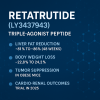Retatrutide (LY3437943) – Extended Research Use & Combination Strategies
Retatrutide is a next-generation triple-receptor agonist peptide developed by Eli Lilly. By simultaneously targeting GLP-1, GIP, and glucagon receptors, it represents a promising tool in metabolic research with expanded potential across obesity, MASLD, visceral fat reduction, and inflammatory modulation. Targeted Use Cases
Targeted Use Cases
1. Visceral / Abdominal Fat ReductionRetatrutide shows strong effects in reducing visceral adipose tissue (VAT), especially abdominal fat—useful in metabolic syndrome, PCOS, and insulin-resistance models. Research models using DEXA or MRI confirm significant VAT reduction compared to placebo-like controls.
2. Refractory Obesity & MASLD Therapy
With up to 86% liver-fat clearance in MASLD subgroups, Retatrutide suits researchers focusing on hepatic steatosis and metabolic-liver axis pathways. MRI-PDFF imaging has shown dramatic reductions over 48 weeks.
3. Female Metabolic Research / PCOS
Retatrutide is applicable in PCOS models due to its effects on hyperinsulinemia and central obesity. It improves beta-cell function and promotes fat oxidation, which may benefit ovarian morphology and metabolic regularity.
4. Inflammatory Modulation
Preclinical data indicate Retatrutide may reduce markers like IL-6 and TNF-α and modulate the gut-liver immune axis. It is potentially useful in MASLD/NASH, metabolic inflammation, and insulin resistance linked to chronic low-grade inflammation.
 Synergistic Peptide Stacks
Synergistic Peptide Stacks
- AOD-9604 enhances lipolysis and targets subcutaneous fat deposits
- Retatrutide complements with appetite suppression and metabolic acceleration
- Ideal for stubborn fat and abdominal fat research protocols
- 5-Amino-1MQ boosts NAD+ levels, improves mitochondrial function, and supports lean muscle preservation
- When combined with Retatrutide, may reduce fat while maintaining lean mass
- MOTS-c enhances insulin sensitivity and mitochondrial biogenesis
- Suitable for advanced models studying fat loss + performance preservation
 Suggested Use Patterns (Human Research Models)
Suggested Use Patterns (Human Research Models)
Note: The following guidance is intended strictly for controlled research environments and must not be interpreted as clinical or therapeutic recommendations. Dosing Considerations for Human-Based Study Design
Dosing Considerations for Human-Based Study Design
- Typical research dosing range:
Studies involving GLP-1/GIP/glucagon agonists often explore starting doses of 0.5–2 mg, titrated weekly or bi-weekly depending on tolerability and biomarker response. - Titration protocol (research models):
- Week 1: 0.5 mg
- Week 2: 1.0 mg
- Week 3–4: 2.0–4.0 mg (adjust based on subject response)
Retatrutide studies commonly follow stepwise escalation to minimize GI-related biomarkers or cortisol spikes.
- Observation window:
- Adipose tissue modulation typically shows measurable change between 4–8 weeks
- Insulin markers (HOMA-IR, C-peptide) shift by week 2–3 in sensitive subjects
- Liver enzyme trends (ALT, AST, hepatic fat %) may require 8+ weeks
- Suggested research frequency:
- Once weekly dosing mirrors human pharmacokinetics observed in Phase 2 trials
- For microdose/metronomic models, alternate-day or bi-daily frequency can be explored at subthreshold doses (e.g., 250–500 mcg)
 Product Quality & Compliance Checklist
Product Quality & Compliance Checklist
- Certificate of Analysis (COA)
- Purity ≥98% confirmed via HPLC and MS
- Batch number, manufacture and expiry date required
- Third-Party Lab Testing
- Look for Janoshik, Eurofins, or comparable reports
- Packaging & Storage
- Lyophilized, vacuum-sealed, with desiccants
- Store at 2–8 °C short-term, -20 °C or lower long-term
- Compliance Labeling
- Must state "For research use only - Not for human consumption"
 Research Use Only
Research Use Only
Retatrutide and related stacks are not FDA-approved and are intended strictly for laboratory research. Do not use in humans. Use under licensed professional oversight. Summary Table
Summary Table
| Research Focus | Observed Benefits |
|---|---|
| VAT / Abdominal Fat | Significant MRI/DEXA-confirmed reductions |
| Liver Fat (MASLD) | Up to 86% fat clearance in 48 weeks |
| PCOS / Female Metabolism | Improved insulin response, reduced central fat |
| Inflammation Control | Lower IL-6, TNF-α; gut-liver signaling modulation |
| Muscle Preservation | Possible with 1MQ/MOTS-c combinations |
| Beta-cell Function | Enhanced first/second phase insulin secretion |
References:
- NEJM, 2023: https://www.nejm.org/doi/full/10.1056/NEJMoa2301972
- Nature Medicine, 2023: https://www.nature.com/articles/s41591-023-02526-0
- ADA Poster, 2023: https://diabetesjournals.org/
- Nature, 2023 (Tumor & IL-6 Data): https://www.nature.com/articles/s41586-023-05834-1
